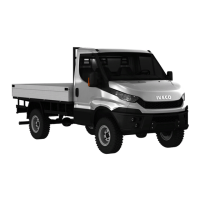22
DAILY 4x4 ‒ GUIDELINES FOR BODYBUILDERS
CHASSIS INTERVENTIONS
2.6 INSTALLING THE TOW HOOK
– Printed 692.68.999 – 3 Ed. - Base 08-2020
2.6.3 Tow hook for trailers with central axle
Centre axle trailers are defined as those that have the drawbar rigidly connected to the frame and the axle (or more close axles)
placed at half the length of the same chassis.
Compared to the articulated drawbars, the rigid drawbar acts on the tow hook with the increase of the static vertical loads and, in
the braking phase or in the oscillations caused by the road surface, the increase of the dynamic vertical loads. By means of the hook,
these loads lead to increases in the torsion of the rear crossbar of the vehicle, as well as push-ups on the overhang.
The use of centre axle trailers therefore requires the use of suitable tow hooks.
The values of the towed weights and vertical loads allowed are listed on the technical documents of the tow hook manufacturer
and on the part manufacture plate (see DIN 74051 and 74052).
For mechanical coupling devices for trailers with a central axle, refer to the following formulas:
D
C
= g (T • C) / (T + C)
V = a • C (X
2
/ L
2
)
D
C
= representative value of tow hook class [kN]. This is defined as the determination of the theoretical reference value for hori-
zontal load between tractor and trailer
g = acceleration of gravity [m/s
2
]
T = maximum weight of the towing vehicle [kg]
R = maximum weight of trailer at full load [kg]
S = vertical static load on the hook [kg], namely the mass part which in static conditions, is transmitted to the coupling point on the
vehicle. S must be ≤ 0.1 x R and, in any case, less than 1000 kg.
C = sum of maximum axial loads of the centre axle trailer at full load. Equal to the maximum weight of the trailer minus the ver-
tical static load (C = R - S) [kg]
V = value of the intensity of the theoretical dynamic vertical force between the vehicle and the trailer [kN]
a = vertical acceleration in the area of the drawbar coupling/hook. in function of the rear tractor suspension, use the following
values:
● a = 1.8 m/s
2
of air suspensions
● a = 2.4 m/s
2
for other types of suspensions
X = length of the load bed [m], (see Figure 11)
L = theoretical drawbar length, distance between the centre of the drawbar eye and the centre line of the trailer axles [m], (see
Figure 11)
X
2
/ L
2
≥ 1 if the result is less than the unit, use the value 1

